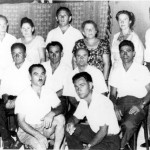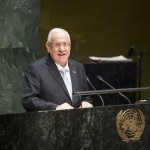“Behold, I have taken out of your hand the cup of reeling, The chalice of My anger; you will never drink it again. I will put it into the hand of your tormentors, who have said to you, ‘Lie down that we may walk over you.” You have even made your back like the ground and like the street for those who walk over it.” (Isaiah 51:22–23)
The Queen of England completed her state visit of England’s former World War II adversary, Germany, by visiting for the first time the Bergen-Belsen death camp. Prince Philip, 94, also joined her.
The Queen was only 19 years of age when the British liberated the camp.
At least 52,000 Europeans were murdered at Bergen-Belson, including the teenage Jewish diarist Anne Frank, whose journal written while in hiding in an Amsterdam loft has been read by millions. It has also been portrayed on the stage and in films.

Netherland’s postage stamp showing an image of Anne Frank, who as a young girl was a victim of the Holocaust. After WWII, she became famous for her diary published as “The Diary of a Young Girl.”
In April of 1945, British forces entered the northern Germany site of the camp where political prisoners, Jews and those of other groups had been held.
The soldiers documented the site with photographs, the first official proof of the Holocaust. (Arutz 7)
This was the Queen’s first trip to a former Nazi death camp.
During her visit to Germany, the Queen also laid a wreath at a memorial for the teenage victim of Nazi brutality and met with camp survivors and former British soldiers who had liberated the camp.

German Nazi physician Fritz Klein stands amid the corpses in Mass Grave 3. The British forced Klein to help bury the piles of unburied corpses. Klein explained how he reconciled his actions with his ethical obligations as a physician; he stated, “My Hippocratic oath tells me to cut a gangrenous appendix out of the human body. The Jews are the gangrenous appendix of mankind. That’s why I cut them out.”
One of the Bergen-Belsen survivors greeted the queen at the site—Rudi Oppenheimer, who was only 12 when the camp was liberated.
“I’m very happy that the Queen can do this for the British soldiers,” he said.
Oppenheimer said these soldiers have been unable to share their experience with their families or anyone else over the years.
“They didn’t tell their wives or their children, they were so horrified by what they saw. All the corpses,” said Oppenheimer. (Times of Israel)
The Queen passed by the mounds holding mass graves and was overheard to say when leaving the site, “It’s difficult to imagine, isn’t it?”
It is 70 years after the Holocaust and only now the world Jewish population of 16 million has reached approximately what it was prior to World War II (16.8 million), according to a report released by the Jerusalem-based Jewish People Policy Institute. (YNet)
At the end of the war, the population of Jews in the world had dropped to 11 million.
According to the report, the number of Jews increased by eight percent between 2005 and 2015, the highest rate of any decade since World War II. The institute defined a Jew by Jewish religious law for those living in Israel and by self-definition for those living abroad.
The number includes the offspring of mixed marriages. If this group is removed from the equation, then the total number of Jews worldwide in 2015 is 14.2 million. (Arutz 7)
Following Israel with its population of 6.1 million Jews, the second largest Jewish population is that of the US which stands at 5.7 million. The third largest Jewish population may be found in France where it is approaching half a million. This is also the country with the largest numbers of immigrants to Israel at the present time.
Russia once had over a million and a half Jews, but following years of Aliyah (immigration) to Israel, now has 186,000. (YNet)










